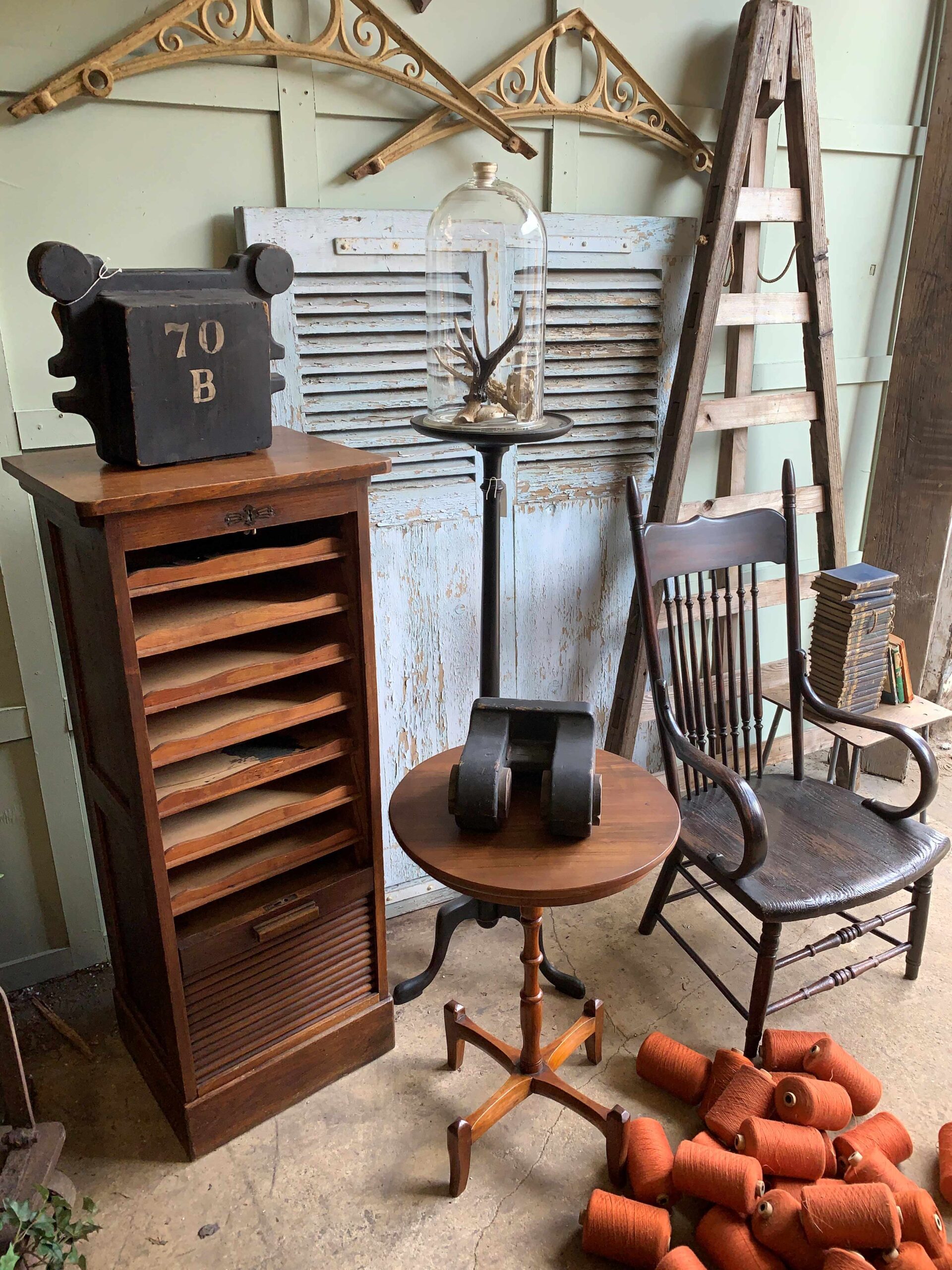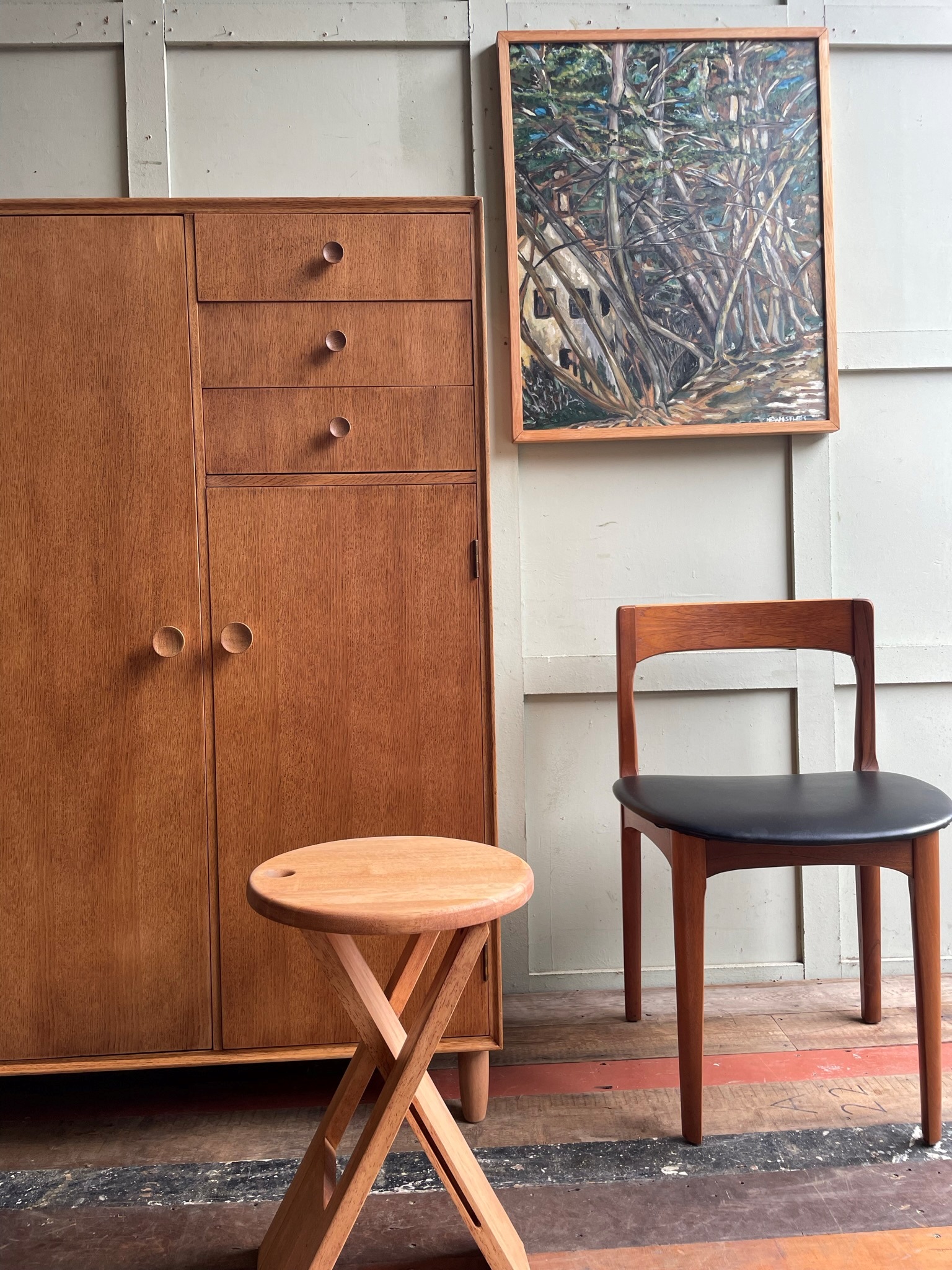Antiques Trade Talks – Metroretro Ltd
 Saxon Durrant runs Metroretro Ltd in Essex where he offers a mix of original vintage and antique pieces, alongside crafting bespoke handmade furniture from reclaimed materials. He tells us about his career in the antiques trade
Saxon Durrant runs Metroretro Ltd in Essex where he offers a mix of original vintage and antique pieces, alongside crafting bespoke handmade furniture from reclaimed materials. He tells us about his career in the antiques trade
How did you get started?
I set up the business officially in the autumn of 1994, although I’d been selling at Camden Stables Market since 1991 and also the Brighton Sunday antiques market where I was at university.
During these early years I shared a shop in Canonbury Lane in Islington and sold at the various Art Deco fairs around London. I was specialising in that period and also the 1950s, whilst becoming increasingly interested in the industrial look which had originally emerged as an interiors style in the US in the 1980s.
By the time I had my own shop in the early 2000s in the Angel area of Islington I was mixing industrial pieces with MidCentury. I was able to buy well in my local area in Essex as well as buying from dealers bringing in furniture directly from Denmark.
Also at this time I started dealing with commercial customers and was soon involved with kitting out pubs and restaurants. Fashion retail soon followed as the concept of ‘retail theatre’ demanded a more immersive shopping experience whereby the fittings and merchandising had to look as desirable as the clothing!
Demand soon outstripped supply and before long the business was manufacturing as well as sourcing vintage. Reclaimed materials were always at the forefront of this and remain so to this day.
I was approached by Selfridges to sell in their Home Accessories department in 2008, at the same time the lease on the shop was coming to an end so the timing was perfect. Following an amazing six years there the business was then solely operated from the warehouse and workshop with online shopping really taking off at this time.
In 2018, I was contacted by the producers of Salvage Hunters to be one of the new dealers in the spin off show Salvage Hunters: The Restorers, having appeared on the original programme in 2015. This was a wonderful experience, working with some great people both in front and behind the cameras that lasted for five series until last year.
Bringing things up to date I am now doing more fairs which gets the stock face to face with the customers. It’s the simplest form of selling and definitely the most enjoyable!
What is the unique appeal of antiques?
I think buying, selling and living with antiques, in the broadest sense, as vintage, reclaim and salvage is almost an act of rebellion. Late-stage capitalism, relying as it does on built in obsolescence and continuous consumption doesn’t really want people messing around with old things or any kind of ‘used’ economy. While antiques, under all its varying definitions, will always be a small part of any economy its devotees can always delight in being slightly outside of the norm.

What areas/items are currently selling well?
Anything for the garden! The pandemic saw a massive increase in gardening which has filtered through to the antiques and salvage market with many choosing outside staples such as planters and benches from the vast and varied reclaimed stock available around the country.
Natural pine has seen a real resurgence in popularity following a few years in the wilderness. There has always been something special about the pale mellow tones of genuinely old pine in its raw state.
Which are the ones to watch/future sellers?
Obviously as time moves on the understanding of what is considered to be ‘vintage’ moves on, too. The 1980s is actually proving to be an interesting period from which to source stock. Well made stylish pieces sell well. I’ll be taking a pair of early 80s Italian chairs to the next MidCentury Show in Dulwich and it will be interesting to see the reaction to them.

What antiques do you have at home/collect and why?
I’ve made quite a few pieces of furniture at home using reclaimed materials as well as having vintage pieces. We bought the house as a doer-upper so I’ve been able to use quite a lot of architectural salvage such as doors, lighting, timber and bricks. I love half glazed doors and one of these has the original rippled glass which casts lovely reflections on the floor when the sun is shining! In recent years I’ve also re-bought a few things that I used to sell when I first started at Camden as they really remind me of my time there.
What do you think will be the antiques of the future?
This is something I often wonder! The build quality of so many things now is unfortunately so poor that I can’t see much surviving long enough to be considered vintage or antique. The designs of what we see in shops and online is generally derivative, its all been done before. There will never be another Art Deco movement or Regency era but their influence can be seen in so much in the built environment and interiors. Will people be drawn to items that are often a poor imitation of the original?
High end design and art will always have a place in the antiques sphere but I can see a situation where the sum total of all the antiques and vintage objects currently in peoples’ homes will just continue to be circulated and traded well into the future without any significant additions to that total of anything from the present day.

Tell us some trade secrets?
I don’t really have any to be honest. There aren’t really and ‘hacks’ or shortcuts. If I was to offer any tips that I’ve learnt from experience they would relate to restoration. Firstly, never underestimate how thin a veneer can be on any piece of MidCentury furniture. I’ve sanded through a few in my time to be greeted usually by chipboard and there’s no way back from that!
Secondly, if you are sanding pitch pine start with a course grit and a light touch as anything finer will clog up your disc or sheet in no time, it’s a very oily wood.
What antiques/artworks would you buy if money were no object?
If it was art I’d buy something by Eric Ravillious or the sculptor Richard Serra. If it was antiques maybe something either from the Omega Workshop, the design company founded by members of The Bloomsbury Group in 1913. I also love the idea of owning something really early, late Medieval perhaps, just to think about how many people had used it or owned it over the centuries.

You’re down to your last 50 quid – what antiques/art would you buy?
I would buy as many small inexpensive things as I could that all needed work. I could therefore add value and hopefully turn a two-figure purchase into three-figure sales.
Where are your favourite antique hunting destinations and why?
My favourite destinations are the ones where what I’m looking for has sat in the same place for years, where I am the first person looking at it with a dealer’s eye. I think most people in the trade would agree that these can be really special moments. I find old things have a stillness and a gravitas to them. Looking at something that is older than you, and will outlive you, made by someone who is no longer around can be quite profound. Fairs and auctions are essential but some of the quiet moments I’ve had looking around rooms in houses and dusty corners of old factories will live long in the memory.

What are some of the biggest mistakes that buyers make – what questions should they ask?
I guess the obvious one is buying things that maybe aren’t quite as old as they look. Reproduction and vintage looking furniture and home accessories can look incredibly genuine. If you are buying these in a high street shop or from a major online seller then the chances are it will be obvious that they are new, and if that is what you are looking for and are happy with that then all is well.
If you are looking for the real thing though and wish to shop more sustainably by buying original vintage then you may be caught out. If you see twenty of the same thing at a fair or in an auction then its fairly clear that the item will be new. Ask the history and date of the item, any honest dealer will share their knowledge happily. Inspect the item carefully, what is your instinct telling you?
Another reason to inspect things closely is looking for damage or bad restoration. I’ve bought lots of pieces over the years and only noticed damage when I’ve got them back to the workshop. While I’m geared up to do repairs they take time, which can effect margins when it comes to re-selling. This is where fairs really win out, you can handle the goods, usually outside in the daylight and meet the seller.
Any styling advice for using antiques in the home?
I think that any antique, vintage item of piece of architectural salvage should be placed in your home so that you get the same feeling that you had when you first laid eyes on it. When you walk in a room they should be the thing that draws your eye. Give pieces room to breathe with as much space around them as you can. Living with antiques and vintage can give a home a really calming and enveloping feel. As I mentioned earlier they are older than you and will probably be around long after you, I can’t think of better house guests.
What do you consider the high point of your career in antiques?
I really enjoyed the early 2010s when the business was running flat out supplying pubs, restaurants, retailers and offices with vintage stock and what was being made in the workshop. In one memorable year I sold over twenty thousand reclaimed wooden apple crates, the vast majority to just two customers, both clothing brands. There was a lot of investment still in the casual dining sector and also bricks and mortar shops.
Maybe the high point is right now as this year the business has its thirtieth birthday!

Are antiques attracting younger buyers and, if not, how can the industry reach out to them?
I’d like to think so but it is so hard for younger people to afford a place of their own now, consequently they are thinking about buying things for their own home at much later stage of life. Sustainability is much more of a concern now, though, so when the time does come the vintage and reclaimed option is attractive from day one. Many dealers have become masters of social media, presenting stock in really imaginative ways and giving real insights into the trade, how things are sourced, their design heritage and where they will be sold. It is a great community with a real spirit of good will. This makes the world of antiques, vintage and salvage accessible and dynamic – #antiquesaregreen!
What advice would you give to people new to antiques who want to learn more?
The easiest first step is to follow dealers on platforms like Instagram. You will see the most amazing stock, looking incredible, beautifully presented by passionate people. Check out the specialist selling platforms such as Vinterior and The Hoarde. What you really can’t beat though is going to a fair or an auction where you can get right in amongst it and indulge your senses. Stick your nose in an old blanket box, run your hands across a chest of drawers, get up close and see the brush strokes on an old oil painting. Everyone should have something old in their house. If you aim to start with just one antique or salvaged item in each room I guarantee that thing will be the first thing that you look at every time you enter. If that brings you joy and meaning, then the amazing world of antiques, vintage and salvage is for you, welcome home.


